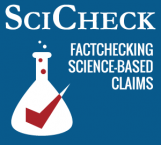SciCheck Digest
Kate Cox petitioned to be allowed to have an abortion in Texas to “protect her life, health, and future fertility,” after receiving news that her baby was unlikely to survive, according to her court filing. A popular Instagram post misrepresented Cox’s specific case and also made misleading claims about trisomy 18, the condition affecting her pregnancy.
Full Story
Abortion is banned in Texas by multiple laws. Texas law contains exceptions for mothers with emergency medical conditions. But according to some doctors and health policy experts, it can be difficult to determine in practice whether a situation qualifies for an exception or to find a doctor or hospital administrators willing to make that judgment given the legal risks involved.
Doctors also have argued that it’s not possible or desirable to establish a formulaic definition of a medical emergency given the complexities and nuances affecting each case.
Even before June 2022, when the Supreme Court overturned Roe v. Wade, the 1973 decision that established a constitutional right to abortion, the procedure was already largely banned in Texas. The state had enacted a law in 2021 that outlawed abortions after “cardiac activity” was detected in an embryo, which occurs at about six weeks of gestation, with an exception only for a medical emergency.

On Dec. 5, Texas resident Kate Cox, her husband and her doctor petitioned for the enforcement of the state’s abortion bans to be temporarily blocked so that Cox’s doctor could legally perform an abortion. The petition argued that continuing the pregnancy, then 20 weeks along, would pose risks to Cox’s life, health and future fertility.
The petition also said that doctors had concluded, based on multiple factors, that Cox’s “baby may not survive to birth and, if so, will only live for minutes, hours, or days.”
These factors included ultrasound images that revealed serious conditions affecting the fetus. They also included a diagnosis in the fetus of full trisomy 18, also known as Edwards syndrome, in which cells throughout the body contain an extra copy of chromosome 18. The condition, which affects the development of multiple organs, is often lethal before birth, or soon after in children who are born alive.
Cox ultimately left the state of Texas to seek an abortion elsewhere, and the Texas Supreme Court ultimately concluded on Dec. 11 that Cox’s petition should not be granted, directing a local court to vacate its prior decision to the contrary. However, misinformation about the case and the survival odds for children with trisomy 18 have continued to circulate online.
A popular Instagram post made a number of misleading claims. For instance, the post stated that “90% of kids with Trisomy 18 live when given proper medical care,” while giving examples of children who defied the odds. According to studies, the median survival time for the condition among babies born alive was four to 14.5 days, and just 5.6% to 8.4% of those born alive lived to their 1st birthday.
The post also misleadingly stated that Cox “does not want to go through labor or c-section for a disabled child.” But Cox’s petition said that doctors concluded based on her specific case that her child would not survive beyond a few days at most.
Dr. Alireza Shamshirsaz, a maternal-fetal medicine specialist, told us that many women who continue a pregnancy with trisomy 18 will end up needing a cesarean section, with all the associated risks for the mother and her future pregnancies.
“If we look at this way, we are increasing the risk to the mom with having no good outcomes for baby,” Shamshirsaz said.
Shamshirsaz is a spokesperson for the Society for Maternal-Fetal Medicine and the American College of Obstetricians and Gynecologists, which wrote an amicus brief advocating that Cox be permitted to receive an abortion.
The Facts About Trisomy 18
Trisomy 18 most commonly arises when an egg cell or sometimes a sperm cell ends up with an extra copy of chromosome 18. The condition is not generally inherited, and risk increases with maternal age.
The Instagram post called trisomy 18 “a genetic condition that causes physical growth delays during fetal development.” Trisomy 18 is indeed associated with slow fetal growth, but this leaves out many other serious problems that may come with the condition. The extra genetic material also leads to issues with the development of multiple organs, including the heart, lungs and brain.
Among trisomy 18 pregnancies that make it to 12 weeks, nearly three-quarters are expected to end in miscarriage or stillbirth, according to a study of pregnancies in England and Wales published in the American Journal of Medical Genetics. In pregnancies that make it to 24 weeks, more than half are expected to end in stillbirth.
As we’ve said, the Instagram post also made the misleading claim that most children with trisomy 18 survive “when given proper medical care.”
While there are children with trisomy 18 who do survive beyond a year of age, this is not the outcome in the majority of cases. In one study, published in the journal of the American Academy of Pediatrics, babies with trisomy 18 who were born alive in the U.S. between the late 1960s and late 1990s died at a median 10 to 14.5 days of age. Just 5.6% to 8.4% of the babies survived until their 1st birthday. A Swiss study, published in the American Journal of Medical Genetics, found that babies with the condition who were born alive between 1964 and 2003 died at a median age of 4 days old and that just 6% were alive after a year.
The Instagram post also did not mention the factors particular to Cox’s case. Her petition stated that ultrasounds showed multiple abnormalities affecting the pregnancy, adding that her specialist doctor told Cox and her family that “given the results of the ultrasound alone, their baby was likely to pass in utero, be stillborn, or only live for a week at most.”
Shamshirsaz said that it’s possible to stratify risks of trisomy 18 based on ultrasound. Factors such as complex heart defects, growth restriction of the fetus and other elements predict worse outcomes. He also said that full trisomy — in which all of a fetus’s cells are affected — is predictive of worse outcomes.
Post Misrepresents Risks of Continuing Pregnancy
The Instagram post also misrepresented the risks of abortion versus continuing the pregnancy, incorrectly stating that the “claim that abortion is the safest option for Kate is false.”
“The risk of the abortion in general is less than continuing the pregnancy” at the gestational age of Cox’s pregnancy, Shamshirsaz said.
Based on medical advice, Cox concluded that dilation and evacuation abortion — a form of procedural abortion — was “the safest option for her health and her best medical option given that she wants to have more children in the future,” according to the petition.
Shamshirsaz said that continuing a pregnancy exposes the mother to risks, including gestational diabetes and preeclampsia, a pregnancy-associated form of high blood pressure.
Cox’s petition said that she was at particularly high risk for gestational diabetes, high blood pressure and other pregnancy complications, based on a test indicating elevated glucose along with “other underlying health conditions.”
The petition also stated that she had been to the emergency room multiple times due to severe cramping, diarrhea and fluid leaks of undetermined origin. The amicus brief said these symptoms are “associated with obstetrical complications.”
The petition said that if unable to get an abortion and if the fetus’s heart stopped beating before term, Cox would receive a labor induction. For people like Cox who have had prior C-sections, induction is associated with elevated risk of uterine rupture, which can lead to complications including removal of the uterus, excessive bleeding and death. Cox is a 31-year-old mother of two children, according to the legal filings.
If the baby reached term, the petition said, Cox would receive a C-section. Trisomy 18 comes with an increased rate of C-section, Shamshirsaz said, and Cox’s history of two prior C-sections makes the surgery even more likely.
Under any circumstances, C-sections come with risks to the mother and her future pregnancies. Risks increase with each C-section a person receives.
Risks to subsequent pregnancies associated with repeat C-sections include uterine rupture, hysterectomy and problems with the placenta. They also include other surgical complications, such as harm to nearby organs like the bladder.
“While Ms. Cox’s life may not be imminently at risk, she is at high risk for many serious medical conditions that pose risks to her future fertility and can become suddenly and unexpectedly life-threatening,” the petition said.
Editor’s note: SciCheck’s articles providing accurate health information and correcting health misinformation are made possible by a grant from the Robert Wood Johnson Foundation. The foundation has no control over FactCheck.org’s editorial decisions, and the views expressed in our articles do not necessarily reflect the views of the foundation.
Sources
“Interactive Map: US Abortion Policies and Access After Roe.” Guttmacher Institute. 20 Dec 2023.
“Now that the Supreme Court has overturned Roe: Texas is enforcing its trigger ban, which prohibits abortion and includes civil and criminal penalties.” Center for Reproductive Rights. Undated, accessed 20 Dec 2023.
Felix, Mabel et al. “A Review of Exceptions in State Abortion Bans: Implications for the Provision of Abortion Services.” KFF. 18 May 2023.
Goodman, J. David. “Abortion Ruling Keeps Texas Doctors Afraid of Prosecution.” New York Times. 13 Dec 2023.
Cox v. Texas. “Brief of Amici Curiae American College of Obstetricians and Gynecologists and Society for Maternal-Fetal Medicine in Opposition to Petition and Emergency Motion for Relief.” Supreme Court of Texas. 11 Dec 2023.
Cox v. State of Texas. “Plaintiffs’ Original Verified Petition for Declaratory Judgment and Application for Temporary Restraining Order and Permanent Injunction.” District Court of Travis County, Texas. 5 Dec 2023.
“Trisomy 18.” Medline Plus. Undated, accessed 20 Dec 2023.
Cox v. Texas. No. 23-0994. Supreme Court of Texas. 11 Dec 2023.
Lila Rose (@lilaroseofficial). “The Kate Cox case is being heavily misrepresented.” Instagram. 13 Dec 2023.
Rasmussen, Sonja A. et al. “Population-Based Analyses of Mortality in Trisomy 13 and Trisomy 18.” Pediatrics. 1 April 2023.
Niedrist, Dunja. “Survival With Trisomy 18—Data From Switzerland.” American Journal of Medical Genetics. 14 April 2006.
“Trisomy 18 and 13.” Children’s Hospital of Philadelphia. Undated, accessed 20 Dec. 2023.
Fisher, J.M. et al. “Trisomy 18: studies of the parent and cell division of origin and the effect of aberrant recombination on nondisjunction.” American Journal of Human Genetics. Mar 1995.
Cereda, Anna and John C. Carey. “The trisomy 18 syndrome.” Orphanet Journal of Rare Diseases. 23 Oct. 2012.
“Trisomy 18: Disease at a Glance.” National Center for Advancing Sciences, Genetic and Rare Diseases Information Center. Undated, accessed 20 Dec. 2023.
Morris, Joan K. and George M. Savva. “The risk of fetal loss following a prenatal diagnosis of trisomy 13 or trisomy 18.” American Journal of Medical Genetics. 4 Feb 2008.
“Abortion Care.” The American College of Obstetricians and Gynecologists. Undated, accessed 20 Dec 2023.
Motomura, Kenichiro et al. “Incidence and outcomes of uterine rupture among women with prior caesarean section: WHO Multicountry Survey on Maternal and Newborn Health.” Scientific Report. 10 Mar 2017.
“Cesarean Delivery on Maternal Request.” Committee Opinion No. 761. The American College of Obstetricians and Gynecologists. Jan 2019.
“Vaginal Birth After Cesarean Delivery (VBAC).” The American College of Obstetricians and Gynecologists. Undated, accessed 20 Dec 2023.
